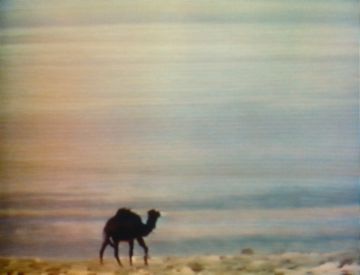
“Part of your preparation is to have as many strings in your hand, just not to knot them,” said Cate Blanchett, explaining her approach to acting. “You don’t want to sort of tie everything up before you perform it. You want to leave it open to what happens in the moment.” I first heard her say this when she appeared on Inside the Actor’s Studio in 2003 and I think about it all the time. Blanchett’s strategy seems as applicable to contemporary art exhibitions as to acting.
I found Narrowcast: Reframing Global Video so resonant partly because it offered me a collection of carefully chosen strands. As a viewer, my job was to move through and experience these strands for myself.
For my last post on Narrowcast, I want to try to do for you what the exhibition did for me: set out a few of the ideas that the work raises and let you move freely through them.

Juan Downey made Shifters in 1984, when video art had barely left infancy. Shifters takes a disorienting journey through a landscape that is political, theoretical, historical, visual, textual–if I tried to list all the applicable adjectives, I’d go on forever. At one moment, Downey has pulled us deep into Napoleonic France; the next moment, he has abandoned us in an Egyptian desert. We are over-saturated with information and images, exposed to so much that we feel we understand nothing at all.

Natalie Bookchin’s trip (2008) feels more familiar and intimate than the journey in Shifters. All the footage is taken out of a car window, so, whether in Indonesia, England, Estonia, or Tijuana, we always feel the presence of the filmmaker. But this “being there” feeling is slightly deceptive: Bookchin never took a road trip. She found the footage, downloaded it from Youtube, and strung together over an hour’s worth of makeshift international videos shot with iphones or digital cameras. Bookchin leads us on a found journey, a simulated trek through virtual landscapes in which we cross world-wide borders without actually going anywhere.

“Do you love daddy better than me?” asks a young girl. “Well,” her mother replies, “it’s a different kind of love. You’ll find out when you grow up.” “When I do, I hope I don’t think it’s silly,” says the girl suspiciously.
Thus begins the part noir, part pop, part documentary montage of Lyn Blumenthal’s Doublecross (1985). Bodies move in and out of each other, hands open and close, a woman is interrogated about her sexuality, two glasses of water are filled and refilled, two buildings mesh.
“It makes everything so much simpler,” says the delicate voice of Audrey Hepburn, and, her voice taken out of context, she seems to be talking about binaries. One and two, male and female, daddy and mommy, single and married, private and public: that’s what makes everything simpler. “The trouble is, people get to attached to each other,” says a voice- over near the end of the film. “Things drag on. Scenes, tears, everything gets so morbid.”

A naked woman–is she 70 years old? Maybe 75?–enters a cold, drab concrete room. She is obviously uncomfortable in front of the camera but she is also slightly excited, anticipating something. Soon, the room fills with naked bodies of different sizes, ages and types. They begin to chase each other and to tag each other. Sometimes, someone will slap someone hard. At other times, the tag will be tentative. It’s childish and absurd, adults playing tag in a windowless, dreary room of that size. Sometimes the bodies move lyrically; sometimes, they move brashly, animalistically.
Half of Artur Zmijewski’s Game of Tag (1999) has been filmed in the basement of an old home. The other half has been filmed in a Polish gas chamber. Distinguishing between the two locales is nearly impossible.



